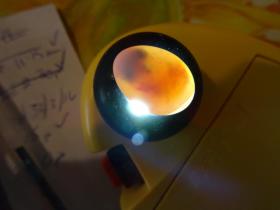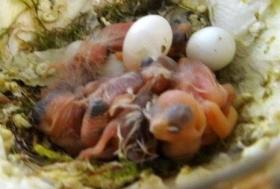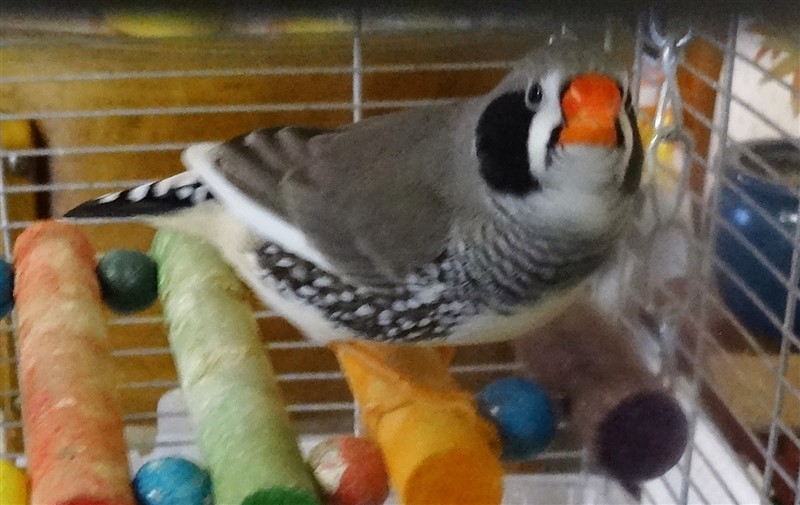
In March 2016 when I was cleaning out some of my cages in the bird shed I found a few eggs had been laid on the bottom of the cages. So instead of binning them I gathered them up and decided I'd pop them into the incubator to find out if any were fertile (I had no idea which birds had laid them).
It turned out two of the eggs were fertile and when I was checking them with the ovascope I could see the image of the actual chick inside the shell.
It turned out two of the eggs were fertile and when I was checking them with the ovascope I could see the image of the actual chick inside the shell.



The other fertile egg hatched out before Shadow.
So I had two chicks to care for.
I left them in the incubator for the first 12 hours - they don't need food during this time they survive on their egg sac.
I began by giving them a few drops of water to which I had added 'electrolyte' (prevents dehydration)
The hand rearing formula I used this time was 'Neocare by Vetafarm'.
I mixed the formula using the electrolyte solution, but still just gave the chicks a few drops at a time. To begin with I used a cocktail stick with the sharp end removed.
So I had two chicks to care for.
I left them in the incubator for the first 12 hours - they don't need food during this time they survive on their egg sac.
I began by giving them a few drops of water to which I had added 'electrolyte' (prevents dehydration)
The hand rearing formula I used this time was 'Neocare by Vetafarm'.
I mixed the formula using the electrolyte solution, but still just gave the chicks a few drops at a time. To begin with I used a cocktail stick with the sharp end removed.

Website designed & built by Elena Djelil
Copyright © 2016 Elena Djelil Les Crouquets, 24590 Jayac, France Tel 00 33 5 53 59 58 45
Copyright © 2016 Elena Djelil Les Crouquets, 24590 Jayac, France Tel 00 33 5 53 59 58 45
_______________________________________________________________________________________










The chick (Shadow) almost fully developed inside the shell on
30th March 2016 and then
newly hatched out on 3rd April
30th March 2016 and then
newly hatched out on 3rd April
My next decision was would I now foster the chicks into a Bengalese nest that already had 3 very young chicks or would I hand rear the chicks myself?
I thought perhaps the new chicks would probably have a better chance of surviving with the Bengalese (I had fostered chicks with them before)
I put the oldest chick into their nest first and when I saw it was being fed I put Shadow into their nest too.
I thought perhaps the new chicks would probably have a better chance of surviving with the Bengalese (I had fostered chicks with them before)
I put the oldest chick into their nest first and when I saw it was being fed I put Shadow into their nest too.

7th April 2016
It's difficult to see the two chicks that are being fostered but they are at the top of the nest. Only 3 of the Bengalese eggs hatched out so they had only 5 chicks to feed and there were 3 Bengalese adult birds in the cage all helping with the feeding.
What happened was actually a mistake made by ME!

Cleaning their cages
After I clean their cages, as usual I remove the cages to clean the shelves the cages sit on - this only takes about three to four minutes , then the cages are returned to exactly the same position they were in before.
The next morning I got a shock -the Bengalese adults were not on the nest as usual and then I realised I had mixed up two cages and their cage hadn't been returned to the exact position the night before.
I feared the worst because I had learned from previous mistakes that if I moved the position of the cage for any longer than 5/10 minutes if the birds had eggs/young in the nest the parent birds came off the nest and didn't go back.
I checked the nest and found that one of the foster chicks was dead, (I was surprised because it was the larger of the two foster chicks that had died) The three Bengalese chicks and Shadow were still alive but not moving they were cold and their crops were empty. If I hadn't checked when I did they would have died too.
I had the incubator switched on in the house, so I quickly removed the 4 chicks and put them into the incubator to warm them up.
After I clean their cages, as usual I remove the cages to clean the shelves the cages sit on - this only takes about three to four minutes , then the cages are returned to exactly the same position they were in before.
The next morning I got a shock -the Bengalese adults were not on the nest as usual and then I realised I had mixed up two cages and their cage hadn't been returned to the exact position the night before.
I feared the worst because I had learned from previous mistakes that if I moved the position of the cage for any longer than 5/10 minutes if the birds had eggs/young in the nest the parent birds came off the nest and didn't go back.
I checked the nest and found that one of the foster chicks was dead, (I was surprised because it was the larger of the two foster chicks that had died) The three Bengalese chicks and Shadow were still alive but not moving they were cold and their crops were empty. If I hadn't checked when I did they would have died too.
I had the incubator switched on in the house, so I quickly removed the 4 chicks and put them into the incubator to warm them up.
As I was also hand rearing 3 cockatiel chicks that had been neglected by their parents (that's another story!!) I had all the things ready for hand rearing the 4 chicks but the intervals for feeding them and the strength of the formula were different to that of the cockatiels (a lot of time would be taken up for this but if I wanted them to survive it would be necessary -that is why I first said DON'T choose to hand feed just to make a bird tame because you will be shocked at the time you have to devote to this.)
Shadow was now 4 days old. Once the chicks were warm and I had fed them I transferred the to a small brooder I had just bought (it was really for heating baby wipes - (Lionheart Baby Wipe Warmer a US product but can be bought in UK)
That first day I fed them every 2 hours up until midnight but I didn't feed them during the night.
Their crop has to completely empty at least once in every 24 hours to prevent health problems occurring.
Shadow was now 4 days old. Once the chicks were warm and I had fed them I transferred the to a small brooder I had just bought (it was really for heating baby wipes - (Lionheart Baby Wipe Warmer a US product but can be bought in UK)
That first day I fed them every 2 hours up until midnight but I didn't feed them during the night.
Their crop has to completely empty at least once in every 24 hours to prevent health problems occurring.

















.jpg)
.jpg)
.jpg)
